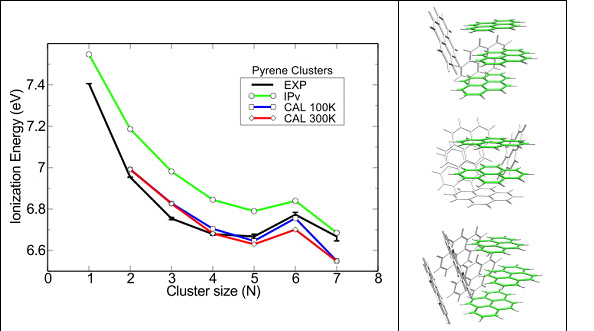Astrophysicists think that polycyclic aromatic hydrocarbons (PAH) are widely present in interstellar space. Nevertheless, their mechanisms of formation by evaporation from carbonaceous nanograins are poorly understood. An interdisciplinary French team including laboratories in Toulouse (IRAP, LCPQ) and the Paris region (DESIRS beamline at SOLEIL, ISMO) have combined the measurement of photoionisation spectra with molecular simulations and have been able to establish the correlation between the structures and electronic properties (ionisation) of PAH clusters in the gas phase, considered as model nanograin systems.
Knowledge of these structures will enable improved characterisation of the properties of these clusters, in particular their spectroscopy and stability. These results are contributing to improving our understanding of the formation and role of these systems in the chemistry of star formation regions as well as in flames.
For over 30 years, astrophysicists have considered that the band emission spectra observed in the 3 - 15 m infra-red range and characteristic of aromatic groups are due to the large PAH molecules which could be produced in interstellar space by evaporation from carbonaceous nanograins. PAH clusters represent a good nanograin model system but little is known about their molecular structure and stability when exposed to UV radiation.
The first experimental measurement of photoelectrons spectra of PAH clusters based upon pyrene C16H10 and coronene C24H12 have been obtained using the photoelectron photoion coincidence imaging technique available on the DESIRS beamline at SOLEIL, which makes use of vacuum ultraviolet (VUV) radiation. This data has been compared with the results of molecular simulations in which the effects of structure and temperature have been taken into account.
For a 6-molecule cluster a certain number of isomers may be present at temperatures of 100 - 200 K. The quality of the agreement between experiments and simulations is sufficient to validate the theoretical approach used. The cluster structures obtained are comprised of multiple stacks when the clusters contain more than 4 monomers. An important result has been to demonstrate that upon ionisation, the charge is not distributed over the whole cluster but remains concentrated on a few molecular units (1 to 3). This behaviour will influence the electronic properties and stability of these systems.

Figure 1: Change in the ionisation energy with size of pyrene (C16H10) clusters. The experimental values (black curve) are compared with the results of molecular simulations (colour curves). The vertical ionisation potential (green curve) has been calculated for the isomers of lowest energy, shown here for 5, 6 and 7 molecules. In these structures, the green molecules are those carrying the charge upon ionisation. At a finite temperature, typically 100 - 200 K in the experiment, the different isomers population must be taken into account in the simulations leading to the red and blue curves which are in very good agreement with the experimental curve.
In astrophysical environments, the PAHs would be produced by destruction (photoevaporation) of very small carbonaceous grains due to the effect of VUV photons. The work presented here constitutes a first step in the study of the process, the PAH clusters being considered as laboratory model systems of the very small cosmic carbonaceous grains. The ionisation properties of PAH clusters (relatively low ionisation energy and highly effective ionisation cross-section) imply that these species would largely be ionised in the environments where these PAHs are formed. Their evaporation properties will therefore differ in comparison with those of neutral clusters which have until now been considered as astrophysical models.
This work is also of interest in the field of hydrocarbon combustion, for example in flames, because it is known that PAHs and possibly their clusters constitute intermediate products in combustion reactions resulting in soot formation.
This interdisciplinary work (CNRS-INSU/INP/INC) was initiated within the framework of the project ANR Gas-phase PAH research for the interstellar medium (GASPARIM, ANR-10- BLAN-0501) and has also benefited from the resources of the project ERC Synergy NANOCOSMOS.
